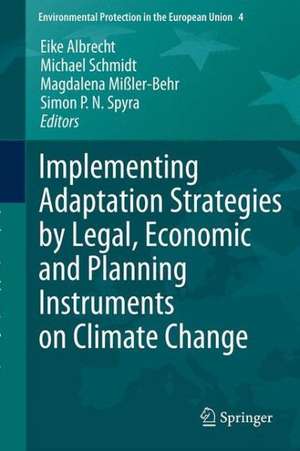Implementing Adaptation Strategies by Legal, Economic and Planning Instruments on Climate Change: Environmental Protection in the European Union, cartea 4
Editat de Eike Albrecht, Michael Schmidt, Magdalena Mißler-Behr, Simon P. N. Spyraen Limba Engleză Hardback – oct 2014
The contributions in this book present a variety of ideas, approaches and tools regarding the adaptation to climate change in specific countries and regions. In addition to examining (existing) legal instruments, they also focus on the implementation of economic instruments and planning tools, as well as their (further) development. Rather than simply discussing strategies to counteract climate change by reducing emissions, the authors also search for ways of actively adapting to climate change.
| Toate formatele și edițiile | Preț | Express |
|---|---|---|
| Paperback (1) | 643.34 lei 6-8 săpt. | |
| Springer Berlin, Heidelberg – 22 sep 2016 | 643.34 lei 6-8 săpt. | |
| Hardback (1) | 649.71 lei 6-8 săpt. | |
| Springer Berlin, Heidelberg – oct 2014 | 649.71 lei 6-8 săpt. |
Preț: 649.71 lei
Preț vechi: 764.37 lei
-15% Nou
Puncte Express: 975
Preț estimativ în valută:
124.32€ • 130.15$ • 102.87£
124.32€ • 130.15$ • 102.87£
Carte tipărită la comandă
Livrare economică 05-19 aprilie
Preluare comenzi: 021 569.72.76
Specificații
ISBN-13: 9783540776130
ISBN-10: 3540776133
Pagini: 340
Ilustrații: XVI, 340 p. 50 illus., 36 illus. in color.
Dimensiuni: 155 x 235 x 25 mm
Greutate: 0.68 kg
Ediția:2014
Editura: Springer Berlin, Heidelberg
Colecția Springer
Seria Environmental Protection in the European Union
Locul publicării:Berlin, Heidelberg, Germany
ISBN-10: 3540776133
Pagini: 340
Ilustrații: XVI, 340 p. 50 illus., 36 illus. in color.
Dimensiuni: 155 x 235 x 25 mm
Greutate: 0.68 kg
Ediția:2014
Editura: Springer Berlin, Heidelberg
Colecția Springer
Seria Environmental Protection in the European Union
Locul publicării:Berlin, Heidelberg, Germany
Public țintă
ResearchCuprins
1. Adaptation to Climate Change in the International Climate Change Regime: Challenges and Responses.- 2. Advancing Forest-Related Adaptation: Options for Adaptation-Oriented REDD+.- 3. Innovation, Adaptation and Climate Change Law.- 4. Managing Adaptation: Developing a Learning Infrastructure in the United States’ Federal System.- 5. Adaptation Strategies in the Netherlands.- 6. Liability for Damage Caused by Climate Change – A Way to Internalize the Costs of Adaptation?.- 7. Strategy Development and Risk Management in the Context of Emission Rights Trading.- 8. The Possibilities and Potential Advantages of the Life Cycle Assessment in the Framework of Climate Change Mitigation.- 9. Framework for Analysing Institutional Capacity for Wetland Management – The Case of the Gemenc Floodplain.- 10. Adaptation to Climate Change in Developing Countries: A Need in the Niger Delta Region of Nigeria.- 11. Climate Change Adaptation and Biodiversity Conservation: An Economic Perspective.- 12. Risk Management and Climate Change: A question of Insurability.- 13. The Cumulative Impacts of Climate Change on Subsistence Agriculture in the Sudano-Sahel Zone of Cameroon: Enhancing Adaptation Policies.- 14. Climate Change in Cameroon and its Impacts on Agriculture.- 15. Cameroon’s Sustainable Forest Management Initiatives with Potentials for Climate Change Mitigation and Adaptation.- 16. The Renewable Energy Resource Act (EEG) as German Way of a Future-Oriented Energy Policy Change.- 17. Climate Change Effects on Agriculture and Water Resources Availability in Syria.- 18. Crowdsourcing and Climate Change: Applications of Collaborative Information Systems for Monitoring and Response.- 19. Beside Adaptation: Concepts for the Future.
Textul de pe ultima copertă
The causes and effects of climate change are just as varied as the proposed solutions and approaches for dealing with the problem. Given the global character of climate change, comprehensive global cooperation is called for that leads to effective and appropriate international action in accordance with the respective responsibilities. These will inevitably differ depending on the capabilities and the social and economic situations of the respective actors.
The contributions in this book present a variety of ideas, approaches and tools regarding the adaptation to climate change in specific countries and regions. In addition to examining (existing) legal instruments, they also focus on the implementation of economic instruments and planning tools, as well as their (further) development. Rather than simply discussing strategies to counteract climate change by reducing emissions, the authors also search for ways of actively adapting to climate change.
The contributions in this book present a variety of ideas, approaches and tools regarding the adaptation to climate change in specific countries and regions. In addition to examining (existing) legal instruments, they also focus on the implementation of economic instruments and planning tools, as well as their (further) development. Rather than simply discussing strategies to counteract climate change by reducing emissions, the authors also search for ways of actively adapting to climate change.
Caracteristici
Examines (existing) legal instruments regarding the adaptation to climate change Focuses on the implementation and development of economic instruments and planning tools Proposes new ways of actively adapting to climate change















